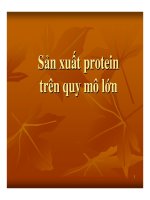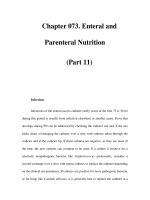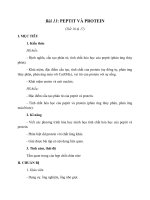11 nutrition recovery protein
Bạn đang xem bản rút gọn của tài liệu. Xem và tải ngay bản đầy đủ của tài liệu tại đây (471.92 KB, 10 trang )
UNIVERSITY
Recovery
Nutrition
Protein Requirements,
Performance, Timing and
Sources
Lesson Overview
•
•
•
•
•
•
Basic Protein Metabolism
Protein effects on Hypertrophy and Body Composition
Protein Intake Recommendations
Protein Meal Timing
Protein Periodization
Protein Safety
Protein
•
•
•
•
•
•
•
Compromised of chains of amino acids
Building blocks for bodily protein
20 amino acids compromise bodily tissues
9 essential amino acids (BCAA: leucine, isoleucine, valine)
4kcal per gram
Protein Turnover constant state
Net Protein Balance: synthesis - degradation
Proteins Effect on Hypertrophy
• Protein alone causes a transient rise in protein synthesis, exercise
potentiates this rise
• Devoid of post exercise protein, protein balance remains negative
• Anabolic sensitivity post training is elevated for 24hours post
workout. 5-6 hours post training greater sensitivity.
• Leucine is the trigger for mTOR activation, all aminos required for
sustained elevation in protein synthesis
• Leucine ”threshold” 2-3g , found in 20-40g high quality protein
sources. Body weight dependent.
• Protein is insulinogenic and insulin rise from protein alone can
suppress protein degradation
Protein on Body Composition
•
•
•
•
Increased satiety
Greater Thermic Effect of Food
Increased partitioning of calories
In a calorie surplus, elevated protein can enhance muscle mass and
keep fat gain decreased
• In a calorie deficit, elevated protein can cause greater fat loss
Recommended Intakes
Dosing based on volume of exercise, age, body composition, total
energy intake and training status of the athlete.
1.0 to 1.5 g/lb of body weight
*amount to maximize MPS and body composition
~20-40g needed to maximize protein synthesis per meal
~70g needed to attenuate muscle protein break down
PED usage still falls within this protein target range
Higher intake may provide favorable body composition changes in
reduction in fat mass
Protein Meal Timing
• MPS increase of 30-100% following protein meal with adequate EAA
• Post meal consumption MPS elevated for 1-4 hours, then decreases.
(Positive Protein Balance)
• Fasting state MPS decrease and Protein degradation increased
• Protein pacing, evenly distributed protein feedings throughout day
• 4-6 boluses ideal
• Amino acid refractory period with too frequent of feedings
• Sipping your aminos throughout day DON’T DO IT
• Night-time protein feeding attenuates protein degradation
250g protein per day= 5-6 meals of 40-50g of protein, evenly spread 34 hours apart
Protein Periodization
Post Show
• Hunger and food focus high
• Propensity for fat gain high
• Increase Protein intake to high end of range
Offseason
• Hunger low
• Carbohydrate high and body fat high
• Decrease protein intake for hunger issues
• Body fat gain more liable protein can be increased
Contest Prep
• Initial phase of prep
•
•
•
•
Increase in protein and decrease in carbs/fats
Satiety
Calorie Partitioning
Muscle Retention
• Late phase of prep
• Decrease protein and allocate to carbohydrate for performance preservation
Protein Safety
High protein intakes in healthy individuals pose no health risk in the
current literature
Multiple studies over one year with protein intakes as high as
2g/kg/day of protein show no harmful effect on blood lipids, kidney
function, liver function, or bone mineral density.
References
Helms ER, Aragon AA, Fitschen PJ. Evidence-based recommendations
for natural bodybuilding contest preparation: nutrition and
supplementation. J Int Soc Sports Nutr. 2014;11:20. Published 2014
May 12. doi:10.1186/1550-2783-11-20
Iraki J, Fitschen P, Espinar S, Helms E. Nutrition Recommendations for
Bodybuilders in the Off-Season: A Narrative Review. Sports (Basel).
2019;7(7):154. Published 2019 Jun 26. doi:10.3390/sports7070154
Schoenfeld B. Science and Development of Muscle Hypertrophy.
Champaign, IL: Human Kinetics; 2021.
Stipanuk M. Biochemical, Physiological, and Molecular Aspects of
Human Nutrition. USA: Elsevier; 2013.









